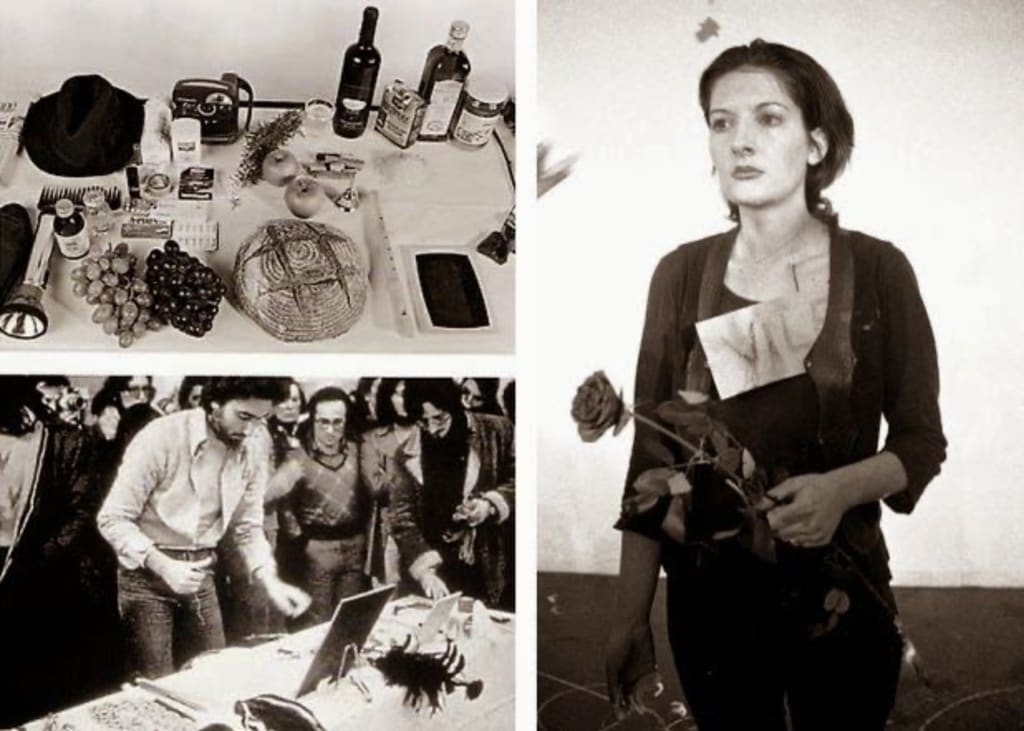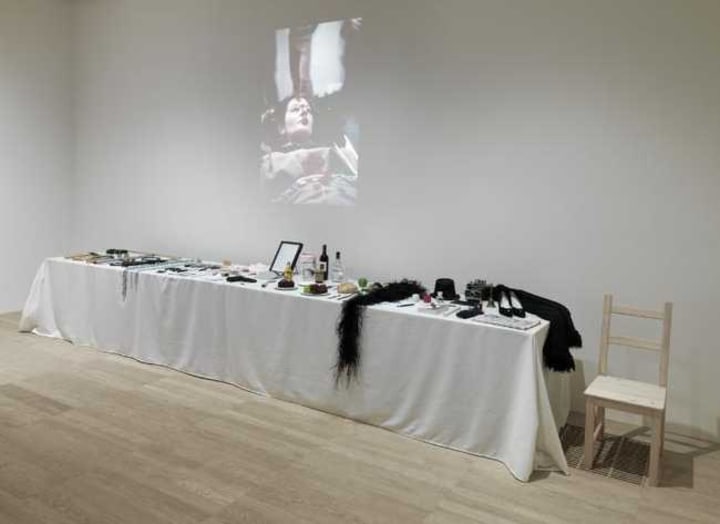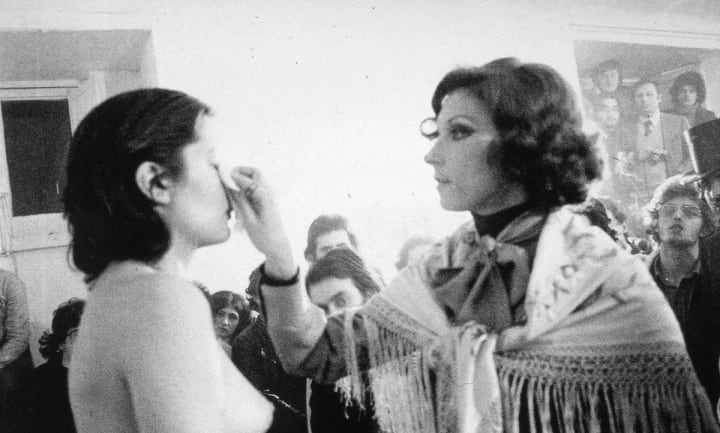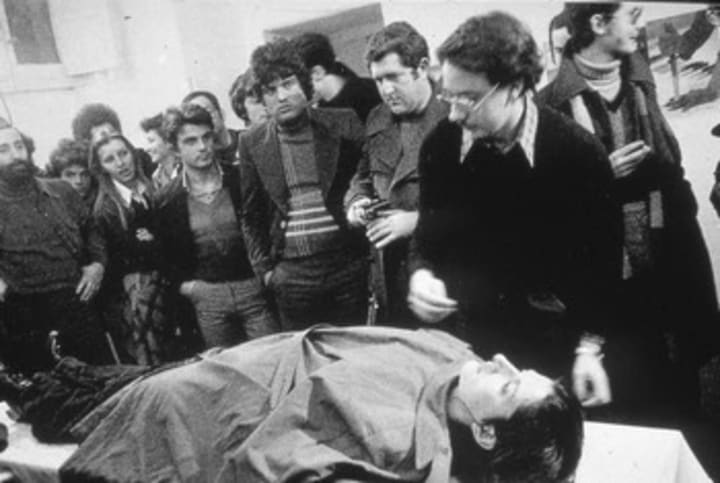Marina Abramovic's Art Performance That Exposed Human Brutality - Rhythm 0
Marina Abramovic's Rhythm 0 (1974) was an experiment that, by testing the limits of human nature, revealed unsettling truths about it.

In her controversial 1974 performance piece Rhythm 0, Marina Abramovic told the audience, "I am the object. During this period, I take full responsibility." A long table in the gallery held seventy-two objects, which the public was free to use on Abramovic as they wished. The objects included knives, scissors, a lamb bone, honey, lipstick, perfume, and olive oil.

The event started off innocently enough as audience members lifted her arms, spun her around, and gave her cheek kisses. However, very soon, the unrestricted participants took control and Abramovic's clothing were ripped off, she was forced onto a table, she was sexually assaulted, and she suffered injuries to her body. To get to her blood, one of the audience members cut her neck. The process culminated when Abramovic's finger was played with to pull the trigger while the pistol was lifted off the table, loaded, and aimed at her head.
Not only was Marina Abramovic's 1974 piece Rhythm 0 an irreplicable piece of art, but it was also an experiment that, by testing the limits of human nature, revealed unsettling truths about it.
Unlike Abramovic's previous performances, Rhythm 0 was made in reaction to allegations that performance art was masochistic and attention-seeking since the pain was not self-inflicted. Consider the previous Rhythm series entries, which all put the performer's tolerance for pain to the test. In Rhythm 5 (1974), she was laying inside a firewood frame till her oxygen ran out. She made 20 incisions with a knife between her splayed fingers in Rhythm 10 (1973). After that, she played a sound recording of the act and attempted to replicate the wounds with a fresh blade.
However, she gave up control in Rhythm 0, allowing the audience to inflict pain (or pleasure, though that was obviously less encouraging), exposing a darkness that extends beyond the performer. She endured six hours of sadistic treatment, obedient as a doll, until a gallerist interrupted the performance, therefore sparing her life. Abramovic then stepped out of her "puppet" persona and made her way towards the crowd, as planned. The participants left the scene, startled by their sudden awareness of the "object" onto whom they had been projecting violent fantasies, unable to process what they had done.

Rhythm 0 encourages discussion on nature, the concept of objectification guilt, choice, and human hostility.
Within a frame, a structure, or a six-hour performance, art manipulates things that we cannot control. It is an organisation of nature. Nature is primal and uncontrolled, and human nature is no exception.
Art just presents it in a form that is acceptable to us. This concept was first proposed by the philosopher Nietzsche, who wrote, "We have arranged for ourselves a world in which we can live — by positing bodies, lines, planes, causes and effects, motion and rest, form and content; without these articles of faith nobody could endure life," in his 1882 book Die fröhliche Wissenschaft (The Gay Science).
Scholar and feminist activist Camille Paglia is renowned for having shared and advanced the idea that art is a barrier against nature. In her 1990 book Sexual Personae, Paglia uses Nietsche's vocabulary of the Apollonian-Dionysian dichotomy to examine art history and Western civilization. "The most effective weapon against the flux of nature," according to her, is art. In Sexual Personae, Paglia describes art as a tool for order, claiming that "only utopian liberals could be surprised that the Nazis were connoisseurs of art."
It is clear that art is forceful and obsessive, especially in the current day when fine art has been pushed away from society. The artist creates art to protect himself, not to save humanity.
In this sense, Rhythm 0 is distinct as it treads carefully on the boundary between the melting chaos of nature and the fascist assembly of art. The Nazi's fondness for great art and Paglia's description of art as "aggressive and compulsive" seem uncannily pertinent in light of what transpired during Abramovic's performance. The devices, meticulously chosen to cause either pleasure or pain, ended up in the hands of individuals who, for the first time in their life, could act without fear of punishment.
Rhythm 0 is an experiment that shows individuals can and will harm others out of morbid curiosity if they are allowed to do so and there are no repercussions. A choice was presented to the participants by the 72 objects: they might have spent the six hours giving Abramovic wine and bread, spritzing her with perfume, and enveloping her in yarn, but that is not at all what happened. Because no one said "no," the audience drank her blood. According to Mary Richards, the author of a book on Abramovic, the audience's behaviour was a result of the dynamics of group psychology. Acting as a group may have temporarily relieved the members of their guilt.

Even though there have been tributes to Abramovic's work, such as that of Lital Dotan, Rhythm 0 will hopefully never be replicated with the same power. In an interview with Abramovic, Dotan even declared, "I don't think it's possible to do a re-performance." A performance is something you can't reverse or redo. Time, environment, and most importantly, the performer are all factors in performance. In agreement, Abramovic remembers viewing a rework of Yoko Ono's Cut Piece and remarks, "And somehow, it was so not working."
Many people saw Rhythm 0 as the darker sibling of Cut Piece (1964), in which Ono asked viewers to chop off her clothes piece by piece. Documentation is another obstacle that prevents the replication of Rhythm 0. In 1974, it was unimaginable for individuals to carry around documentation tools like mobile cameras as they do now. All of the information we know about Rhythm 0 comes from vocal testimonies from participants, spectators, and Abramovic herself, as well as pictures and audio recordings. If the entire thing had been recorded, and the crowd knew this, they would never have behaved as they did. Furthermore, the performance's uniqueness and elusiveness contribute to its attraction: A horrific tale in which rhythm zero turns into legend.
Like every work of art created by a woman, Rhythm 0 is commonly seen as a feminist creation. But according to Abramovic, the work came from a very "male" place inside of her that gave her the confidence to execute it rather than from feminine energy. Most significantly, by entrusting the artist's life to the audience, the work addressed the objections levelled against performance art. An issue that male artists do not encounter is the automatic interpretation of Rhythm 0—or any other performance by Abramovic, for that matter—as a feminist work, which inhibits other readings and lessons to be gained from the work.
When the work of a female artist is labelled as “feminist” without the artist herself identifying it as such, it is demeaning and treats women’s art differently from that of males, making it inferior.
Nevertheless, it's intriguing to speculate about how Rhythm 0 would have turned out if a male had performed it. The cultural and symbolic significance of the female body is essential, and it frequently takes the form of sexual objectification. Not only is Abramovic's sexual assault a clear example of objectification, but her clothing was also taken off.
Unlike Ono's Cut Piece, which is sometimes compared to it, where the audience is urged to take off the performer's clothes, the participants in Rhythm 0 did not require any guidance to strip Abramovic nude. It's unclear if this was done to compel the stoic artist to respond or out of a perverted curiosity. The same remains true for the other acts committed against Abramovic, such the gun-teasing and the woundings.

Rhythm 0 depicts the objectification, exploitation, and sexualization of a female body, but it also teaches us important lessons about human aggression, social interaction, and our responsibility to those around us.
Importantly, it's also about humiliation, as evidenced by the fact that as soon as Abramovic displayed even the slightest hint of humanity, the crowd left the scene: A sign that she was not simply a body. The crowd felt bad about what they did and could not stand to confront her, which suggests a lightness in human nature that was lacking from the previous six hours of the play. Hence, Rhythm 0 explores issues beyond femininity, including our ability to harm others, the reasons we provide for doing so (such as Abramovic's assertion that she was "the object" and the audience's collective action), and the moral ramifications of our actions.
Even now, almost 50 years after its premiere, Rhythm 0 remains a powerful portrait of human nature. It demonstrated how simple it is for people to defend unfair actions when working together. It is a social experiment as well as a benchmark for performance art, concealing the boundaries between nature and art by fully surrendering physical liberty in order to explore the limits of free choice without repercussions or oversight. The performance of Rhythm 0 and our lives now are so disconnected in time that the piece has taken on the qualities of a terrible horror story or fable.
However, Marina Abramovic's act was real, and she is still scarred. We must constantly remind ourselves that this darkness is a part of us and that it actually happened in order to truly understand the significance of this work and many other historical occurrences. Rhythm 0 aids in the conceptualization of humanity's pathological potential as well as our crucial ethical duty to others.
Thank you for reading my newest story!
What are your thoughts on this one? Is it simply a performance art, or a horrifying experiment?
About the Creator
Victoria Velkova
With a passion for words and a love of storytelling.
Reader insights
Outstanding
Excellent work. Looking forward to reading more!
Top insights
Compelling and original writing
Creative use of language & vocab
Easy to read and follow
Well-structured & engaging content
Excellent storytelling
Original narrative & well developed characters
Expert insights and opinions
Arguments were carefully researched and presented
Eye opening
Niche topic & fresh perspectives
Masterful proofreading
Zero grammar & spelling mistakes
On-point and relevant
Writing reflected the title & theme






Comments
There are no comments for this story
Be the first to respond and start the conversation.